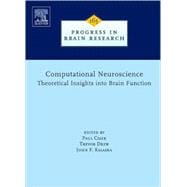
What is included with this book?
| The neuronal transfer function: contributions from voltage and time-dependent mechanisms | |
| A simple growth model constructs critical avalanche networks | |
| The dynamics of visual responses in the primary visual cortex | |
| A quantitative theory of immediate visual recognition | |
| Attention in hierarchical models of object recognition | |
| Towards a unified theory of neocortex: laminar cortical circuits for vision and cognition | |
| Real-time neural coding of memory | |
| Beyond timing in the auditory brainstem: intensity in the avian cochlear nucleus angularis | |
| Neural strategies for optimal processing of sensory signals | |
| Coordinate transformations and sensory integration in the detection of spatial orientation and self-motion: from models to experiments | |
| Sensorimotor optimization in higher dimensions | |
| How tightly tuned are network parameters? Insight from computational and experimental studies in small rhythmic motor networks | |
| Spatial organization and state-dependent mechanisms for respiratory rhythm and pattern generation | |
| Modeling a vertebrate motor system pattern generation, steering and control of body orientation | |
| Modeling the mammalian locomotor CPG: insights from mistakes and perturbations | |
| The neuromechanical tuning hypothesis | |
| Threshold position control and the principle of minimal interaction in motor actions | |
| Modelling sensorimotor control of human upright stance | |
| Dimensional reduction in sensorimotor systems: a framework for understanding muscle coordination of posture | |
| Primitives, premotor drives and pattern generation: a combined computational and neuroethological perspective | |
| A multi-level approach to understanding upper limb function | |
| How is somatosensory information used to adapt to changes in the mechanical environment? | |
| Trial-by-trial motor adaptation: a window into elemental neural computation | |
| Towards a computational neuropsychology of action | |
| Motor control in a meta-network with attractor dynamics | |
| Computing movement geometry a step in sensory-motor transformations | |
| Dynamics systems versus optimal control a unifying view | |
| Table of Contents provided by Publisher. All Rights Reserved. |
The New copy of this book will include any supplemental materials advertised. Please check the title of the book to determine if it should include any access cards, study guides, lab manuals, CDs, etc.
The Used, Rental and eBook copies of this book are not guaranteed to include any supplemental materials. Typically, only the book itself is included. This is true even if the title states it includes any access cards, study guides, lab manuals, CDs, etc.